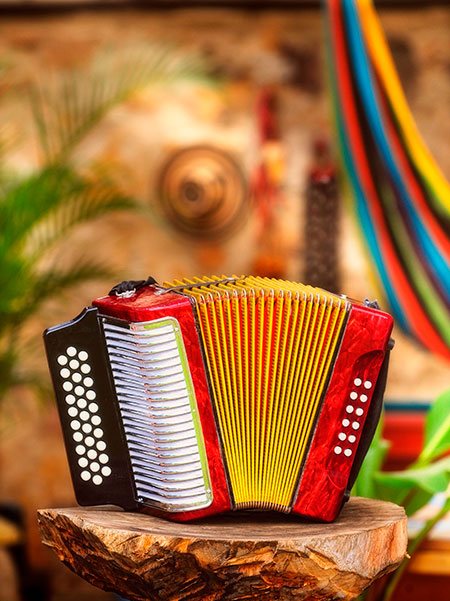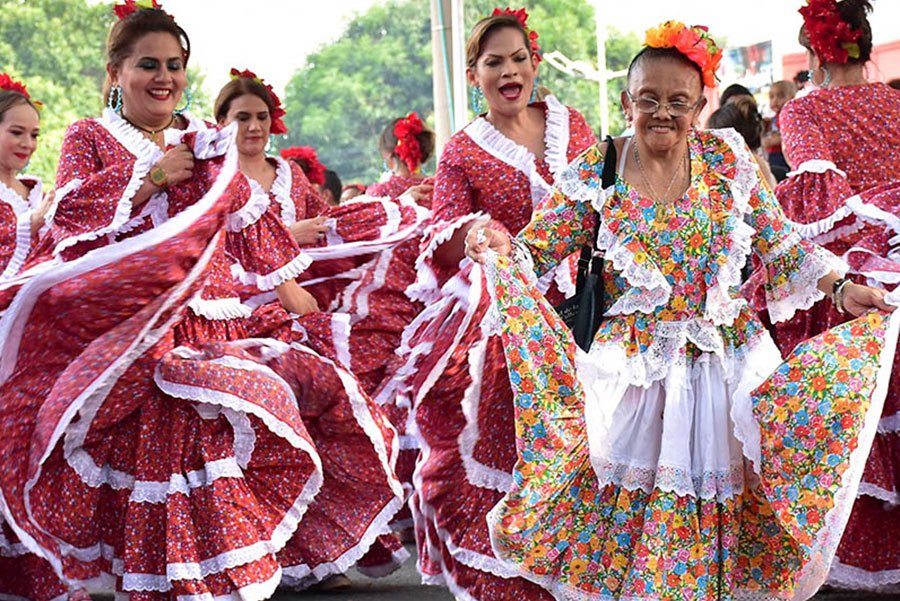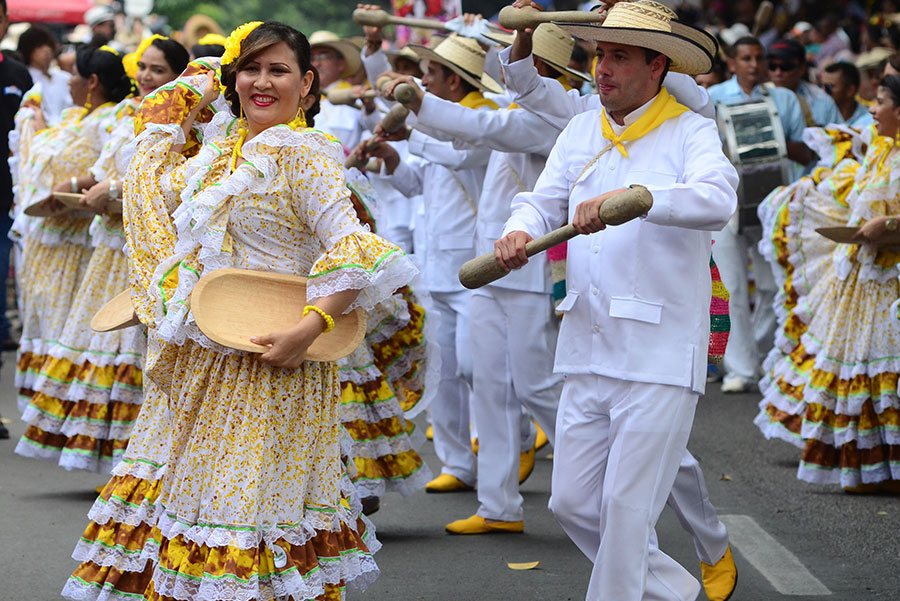COLOMBIA
Experience the Festival Vallenato, or the Festival de la Leyenda Vallenata, in Valledupar and discover all the activities you can enjoy during your visit.
Vallenato is a Colombian music genre that represents the folklore of the Colombian Caribbean Coast. Its popularity reaches far beyond national territory, even reaching as far as countries like Panama, Ecuador, and Mexico. One of the most prominent characteristics of the vallenato is that it is played with three instruments that do not need any kind of amplification: the snare drum and the guacharaca on the percussion side, and the accordion which plays the melody.
The traditional airs (rhythms) of the vallenato are: Merengue, Paseo, Son, and Puya.
Merengue:The Merengue differs from the rest of the airs in the interpretation and marking of the basses.
Paseo: a rhythm from the Magdalena river region inherited from the indigenous and African traditions.
Puya: a rhythm closely related to cumbia but with a faster pace.
Vallenato music has reached so much popularity, that in 2015, the United Nations Educational, Scientific and Cultural Organization (UNESCO) declared it an Intangible Cultural Heritage of Humanity.

What is the Festival Vallenato or The Festival de la Leyenda Vallenata?
The Festival Vallenato is a folk festival in Valledupar that has brought together the greatest composers and interpreters of the vallenato musical genre since 1968. The main event of the contest is a competition between male and female accordion players of all ages to be recognized as King and Queen. This award denotes the best exponents of this folklore.
The categories of interpretation of the different rhythms of the genre in the festival vallenato range from Youth and Children, to Amateur and Professional.
In the same way, there are also alternate contests in the Festival Vallenato held between composers, repentistas -those who improvise songs and music in the form of poetry- and piloneras, or dancers of the traditional Pilón dance (large wooden bowls that were used to grind corn).

Women dances the “Pilón dance” during the festival Vallenato
Activities during the Festival Vallenato
During the four days in which the Festival Vallenato is held, you can enjoy different activities in the city such as the Jeeps "Los Willys Parranderos" parade. It is a caravan of more than 60 cars that honor the tradition of old parranderos (partygoers) who used to carry a vallenato group in the back and travel to nearby towns. This activity marks the beginning of the festival.
Another outstanding activity you can experience, which also kicks off the Festival Vallenato, is the Piloneras parade. This event is held to honor the traditional custom of women who sang verses during household chores related to corn consumption. For this reason, women wear colorful dresses and go out on the streets with their pilones (no longer wooden, but representative) and perform “the pilon dance” with their partners, who are dressed in the peasant garb of that time.
You might also be interested: Feel the rhythm: Where to go out dancing in Colombia

A couple of dancers during the Piloneras Parade
Other activities you can enjoy in Valledupar during the Festival Vallenato
Valledupar is a municipality in northern Colombia, known worldwide for being the "crib of Vallenato". It has the beautiful Guatapurí river running through the city which originates from the foothills of the Sierra Nevada de Santa Marta, its name means "cold water". It is a wooded territory with a warm climate. Eight blocks of traditional colonial houses and buildings that make up its historic center frame the Main Plaza Alfonso López . Among those is the traditional church of La Inmaculada Concepción, home to historical relics, paintings, and artistic objects. One of the most emblematic is El Santo Ecce Homo - the saint patron of Valledupar - an ebony wood carving that dates back to approximately 1536 and is considered a national treasure with the venue in which it resides.
In the historic center of the city you'll also find the church of Nuestra Señora del Rosario, where the carved wooden image of the Virgen del Rosario from 1534, who is also a patron saint of Valledupar, rests. Also, in the main square is the 'Francisco El Hombre' platform, where the festival vallenato was held for many years and today is the venue for different cultural events. Also, around the square you can find restaurants with fantastic gastronomy and cultural and commercial venues stand out attracting visitors. Be sure to stop by the Calle Grande Artisan Center during the Festival Vallenato, an ideal place to do your shopping.
A few minutes from the main square is the Accordion House Museum, an archive that exhibits a wide showcase of the Festival Vallenato flagship instrument: the accordion. A tour is offered here that explains the evolution of this important element of vallenato folklore.
Discover: 4 Reasons Cali should be at the top of your vacation list
Things you can do close to Valledupar during your visit to the Festival Vallenato
One of the most common activities to enjoy in Valledupar before, during or after the Festival Vallenato is to travel the "Route of Rivers and Tradition". This plan encourages tourists to soak in the territory's nature, folklore, cuisine and unique cultural offerings.
Along the Guatapurí River there are many tourist attractions, a particular favorite being natural pools called "balnearios". The best known are:
Balneario Hurtado
Ideal for people who want to enjoy a relaxing environment near the river that sprouts from the Sierra Nevada de Santa Marta , adorned with extensive vegetation.
Balneario La Mina
Along the same route you'll find the Badillo River and imposing, immense rocks that make this a natural pool.
Balneario La Vega - Patillal
About 20 minutes from Valledupar, this location is one of many channels through which the Badillo River passes.
On that same route, which goes to the Guajira region, is the town of La Junta, another epicenter of composers that has its own festival vallenato, but focused on guitars.
Towards the south of the city of Valledupar is the town of La Paz, a land of composers and musicians who have also participated in the Festival Vallenato. This area is also known for its delicious almojábanas (natural cornbread that is cooked in clay ovens).
To the west of Valledupar is Pueblo Bello, another indigenous town that rests in the foothills of the Sierra Nevada de Santa Marta. Advancing from there, you can reach Nabusímake , a sacred territory of the Arhuacos indigenous population where, in different tours by car and foot, you will be able to appreciate groupings of straw, bahareque, and stone houses.
Birdwatching in Valledupar, another activity you can do during the Festival Vallenato
Due to the geographical location of the region, which includes the Ciénaga de Zapatosa (the largest freshwater complex in the country), the Serranía del Perijá and the Sierra Nevada de Santa Marta, this place is ideal for birdwatching. In fact, up to 500 species can be found here, of which 100 are migratory.
If you are interested in this activity we recommend the following places to do it:
-
In Valledupar: Los Besotes Eco Park.
-
High mountain from the Manaure: The Chamicero del Perijá Natural Reserve.
-
Low mountain from the Manaure: The Natural Reserve Los Tananeos.
Don't miss the Festival Vallenato in Valledupar and experience all of the wonders that surround the region.

















